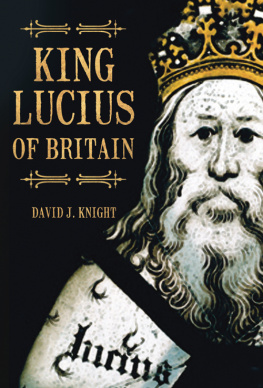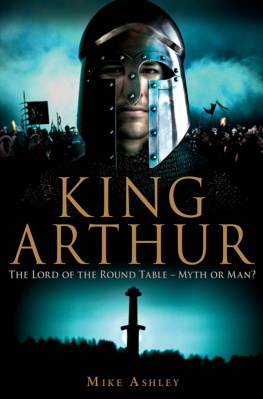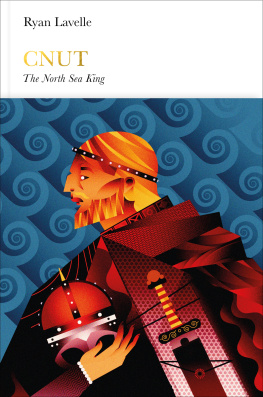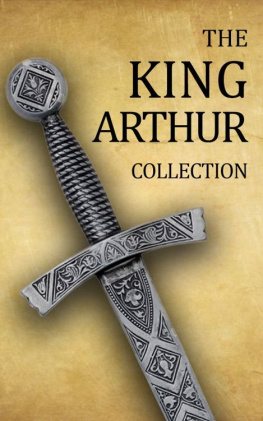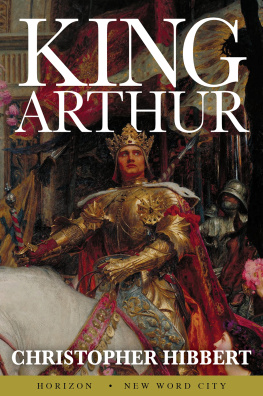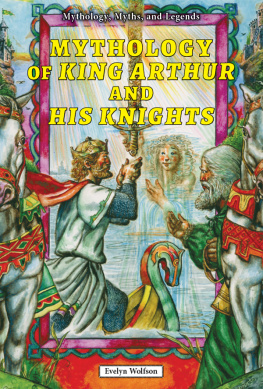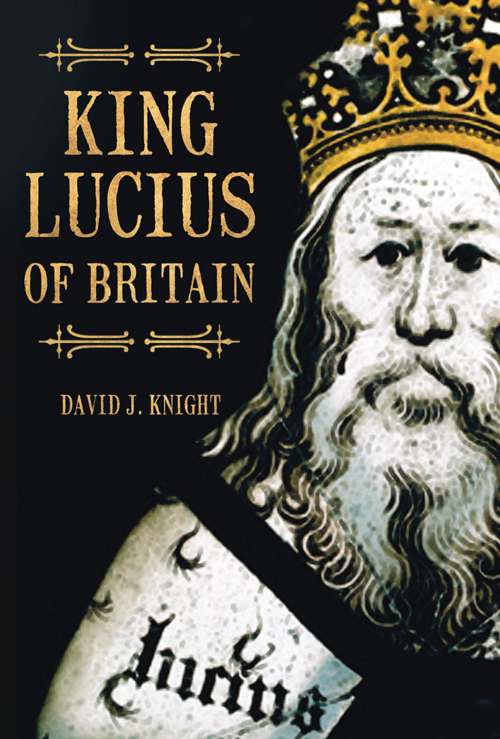KING
LUCIUS
OF BRITAIN
KING
LUCIUS
OF BRITAIN
DAVID J. KNIGHT

In Loving Memory of
My Grandmother Eva Fripp 1906-1993 (Switzerland)
My Uncle Alfred Thomas Knight 1914-1996 (London)
First published 2008
The History Press
The Mill, Brimscombe Port
Stroud, Gloucestershire, GL5 2QG
www.thehistorypress.co.uk
This ebook edition first published in 2012
All rights reserved
David J. Knight, 2008, 2012
The right of David J. Knight, to be identified as the Author of this work has been asserted in accordance with the Copyrights, Designs and Patents Act 1988.
This ebook is copyright material and must not be copied, reproduced, transferred, distributed, leased, licensed or publicly performed or used in any way except as specifically permitted in writing by the publishers, as allowed under the terms and conditions under which it was purchased or as strictly permitted by applicable copyright law. Any unauthorised distribution or use of this text may be a direct infringement of the authors and publishers rights, and those responsible may be liable in law accordingly.
EPUB ISBN 978 0 7524 7446 5
MOBI ISBN 978 0 7524 7445 8
Original typesetting by The History Press
CONTENTS
ACKNOWLEDGEMENTS
I would like to thank Peter Kemmis Betty, Tom Vivian, Abigail Green and Wendy Logue at Tempus for encouraging me to publish this work and their unfailing assistance in doing so.
My heartfelt appreciation and thanks to my mother, Audrey E., and father, Daniel J. Knight, my sister Dr Kim Knight-Picketts, Al Picketts, Jennifer and Amie. Dr Gary D. Knight for consistent support, encouragement and for lending his talents in enthusiastically reading and making editorial suggestions for 12 years, impossible without the love and support of Sheila Knight and Rachel Harris. My warm thanks to Gianna Giannakopoulou not only for her assistance with Greek translations, Chart C.2 and footnoting, but also for keeping me focused at times when the task seemed impossible.
The generous assistance of several organisations made my research possible and I would like to thank in particular Professor Juerg Simonett and Andrea Holme of the Raetische Museum of Chur, Switzerland, and the resources and facilities I have accessed at St Pauls University Pontifical Library (Jean-Leon Allie), Ottawa, Canada, The Bodleian Library, Oxford, The Greater London Records Office, The Guildhall Library, London, and The British Library, London. The majority of the research for this work took place between 1995 and 2007, and having immersed myself in this material I am grateful to Dr Niall Finneran for suggesting I submit a book proposal to Tempus.
The immense task of preparing this book would have been insurmountable without the generous interest, support and professionalism of several friends and colleagues. I would like to particularly thank Dr Charlotte Tupman for spending some time with the Vita Lucii and sieving out the most important elements from the original Latin, Tehmina Goskar for eagerly translating the Letter of Eleutherius, and Dominic Barker for preparing several maps and plans. Thanks also to Martin Fitzsimons of St Helens House, Bishopsgate, London, who has been an invaluable friendly contact for allowing me access into the dark corners of St Peter-upon-Cornhill.
Gaining permissions and preparing the images for this book would not have been possible without the genuine interest of The Dean and Chapter of York Minster, especially Amanda Daw and Vicky Harrison, and the Dean and Chapter of Gloucester Cathedral, especially Mark Beckett (Chapter Steward), Robin Lunn and Richard Cann. Thanks are also due to Gareth Beale, Nick Schiavottiello and Mary Stubbington for their assistance.
The support of friends so often goes unsaid, therefore I would like to thank Mark and Jill, Daisy and Ben Houliston, Tom and Tehmina Goskar, Nick and Carol Ford, Francis P.D. Crosby, John R. Dowling, Jackie Laing, Greg Robertson, Sylvia Galletta, Jennifer Liefeld-OBrien, Saleh Al Hassy, Joe Viall, Kevin and Pauline Hogg, Catherine Taylor and Patty Murrieta.
While I was collecting and noting the vast diverse elements for the book I made the happy discovery of J.B. Segals important contribution to a debate over Harnacks conclusions. I would like to extend a warm thank you to the overwhelming generosity and encouragement of Mrs Leah Segal and Dr Naomi Segal, allowing me to initiate the J.B. Segal Collection at the Parkes Institute, University of Southampton, UK, with the additional interest and aid of Chris Woolgar (Parkes Institute) and Dr Dan Levene (University of Southampton).
FOREWORD
When we try and explore the extent of Christianity in Roman Britain we look through a glass darkly. The evidence for early Christianity in Britain is often intractable, whether using the documentary sources or the archaeological material. The textual evidence of all aspects of late Roman and early medieval society is sparse, and was often re-worked and embroidered for a range of political and theological purposes. Equally, the material culture evidence can be difficult to interpret, with particular problems in understanding the chronology of the spread of Christianity in the diocese and recognizing diagnostically distinctive artefacts.
As David Knight shows, the material relating to the establishment of Christianity in Britain was particularly vulnerable to emendation, editorialising and fabrication, as individuals and factions of all periods from the fourth century to the nineteenth century used the meagre documentary record to sketch out the earliest origins of the faith in this country. Beyond the brief references in the work of some of the church fathers and the Confessio and Epistola of Patrick there is relatively little contemporary documentary evidence for Christianity in Roman Britain. Most historical accounts instead rely on the versions of the introduction of the religion in the De Excidio of Gildas and Bedes Ecclesiastical History. Whilst both these works have their strengths they are difficult texts and cannot be read as simple historical expositions, rather they are ideologically charged manifestos linking the development of Christianity in Britain to the unfolding of the perceived manifest dynasty of the Church. As such, it is often assumed that much that is set out in these documents, which does not seemingly chime with our understanding of events are simply misunderstandings, legends or myths.
It is easy to overlook or ignore facts or ideas that do not fit into our pre-existing mental frameworks. In this book the author performs a signal service in returning to the story of Lucius and Eleutherius with an open mind. Much of the book consists of a detailed unpicking of the treatment of King Lucius in traditional history and modern scholarship. He traces the creation and growth of the figure of Lucius from his first appearance in the Liber Pontificalis, following the slow accretion of myth and legend around him to the complete dismissal of his story as one of mistaken identity in the early twentieth century. The author tries to re-claim Lucius from this charge and repatriate him from Edessa to Britain. Knights attempt to re-construct a brief biography of Lucius is bound to stimulate debate, but if in the process we rethink the ways in which we understand some of the earliest evidence for Christianity in Britain, this can be no bad thing.

